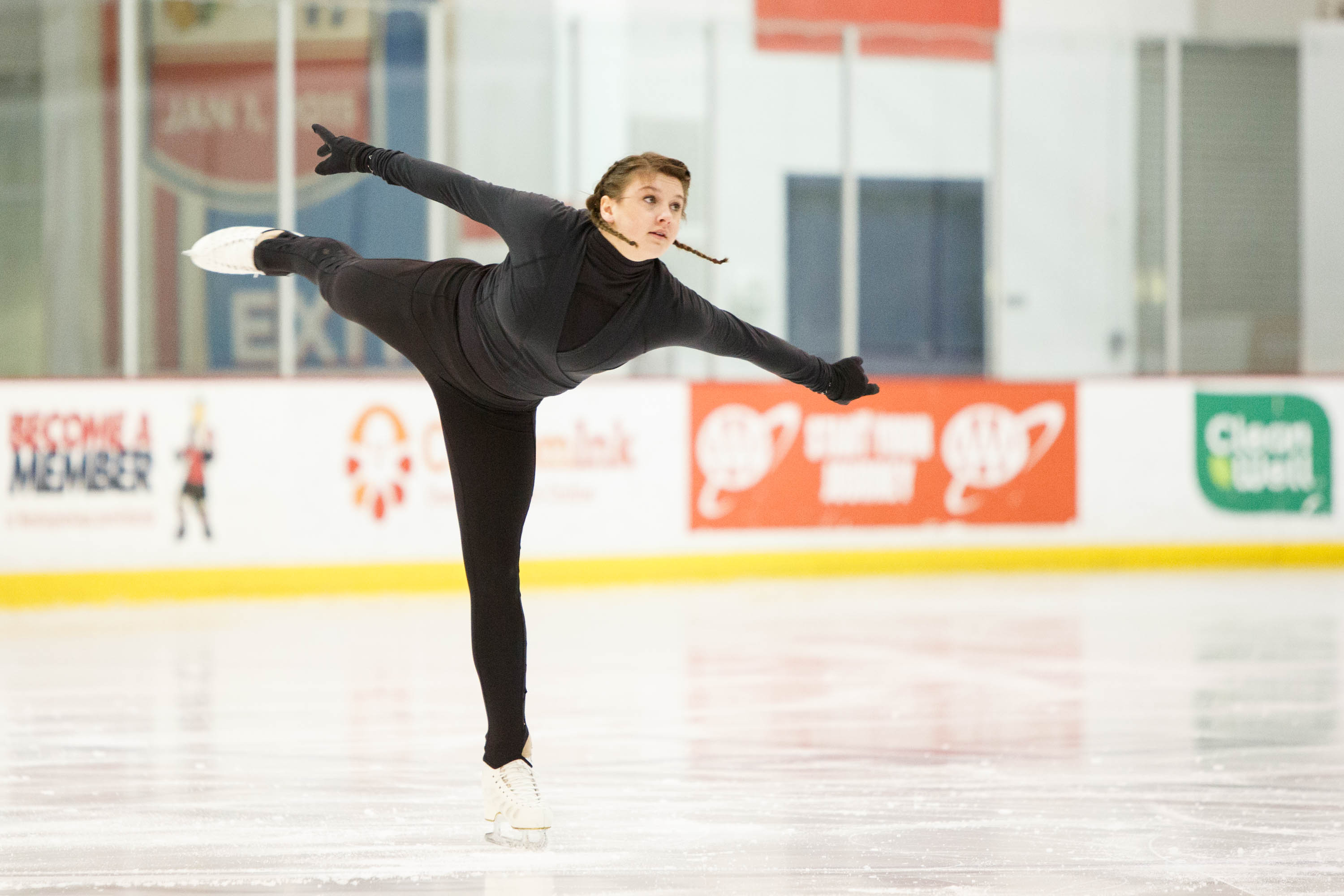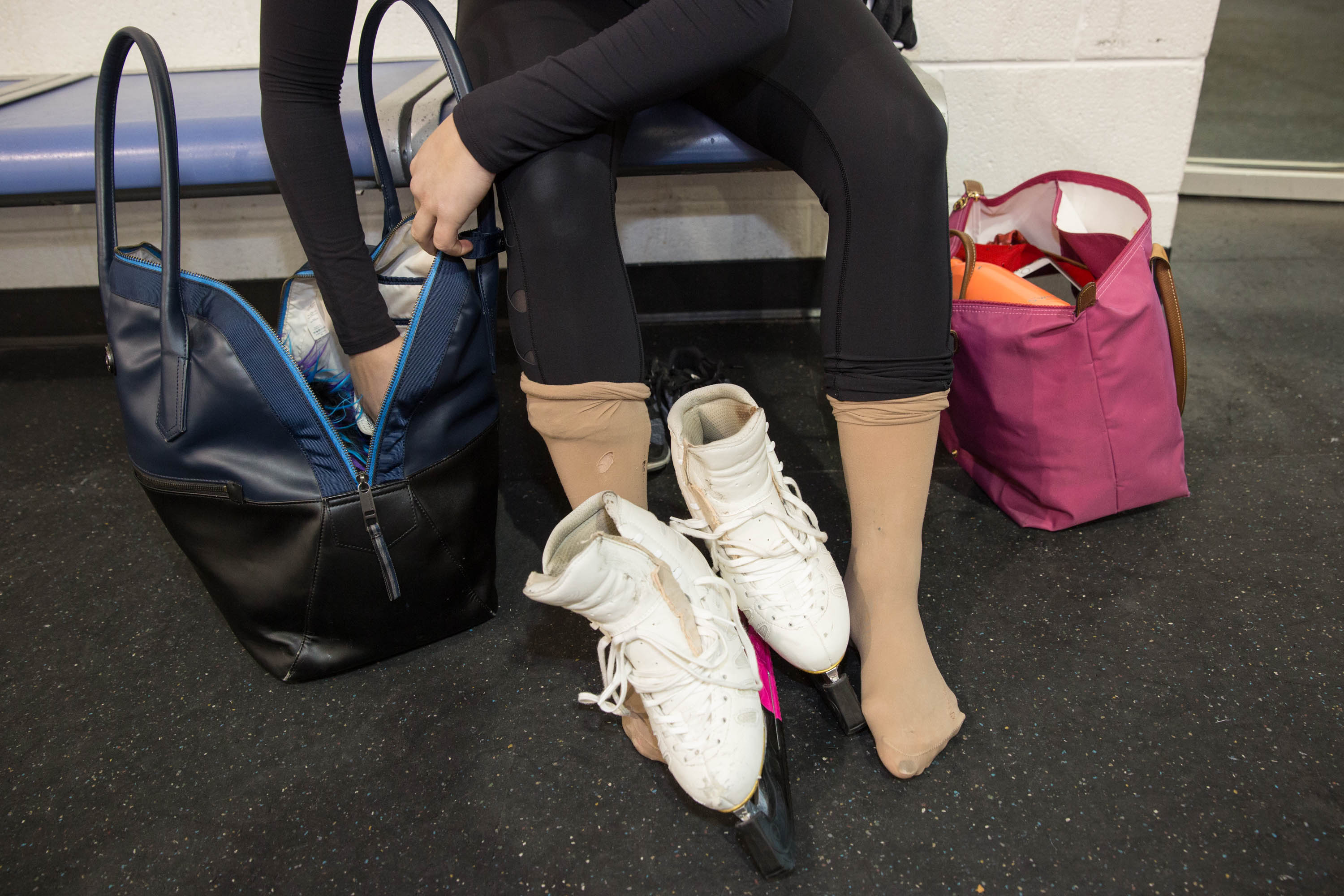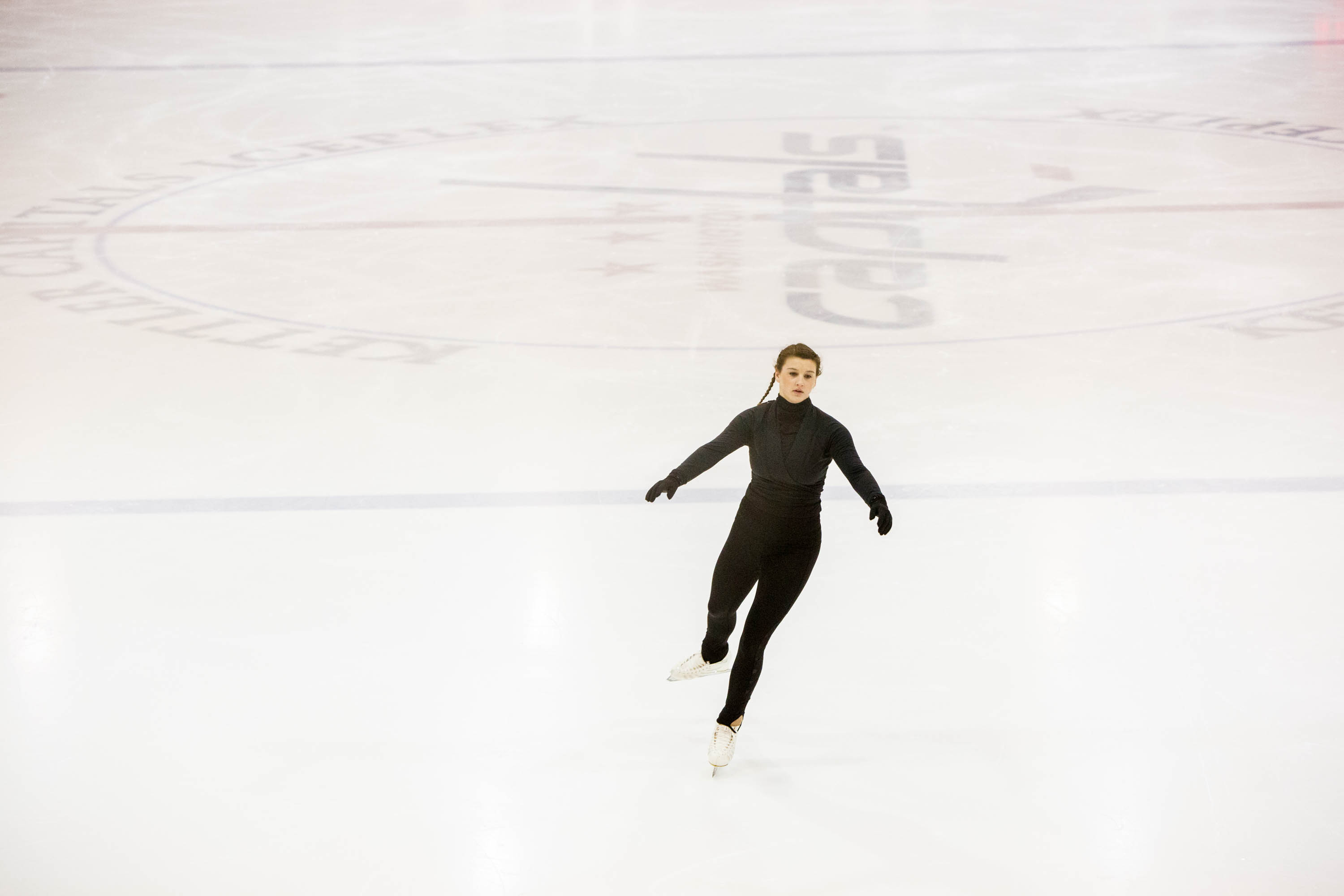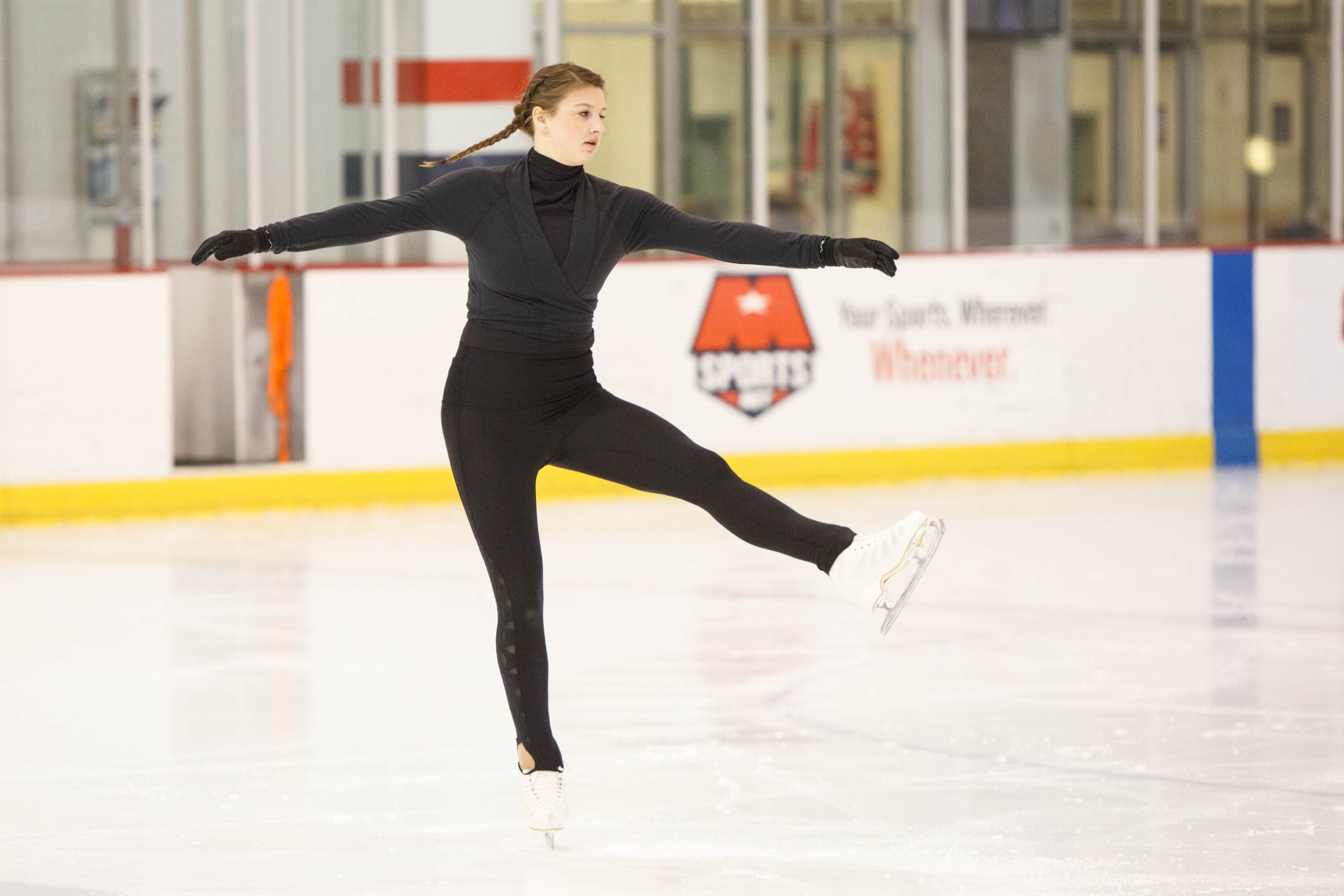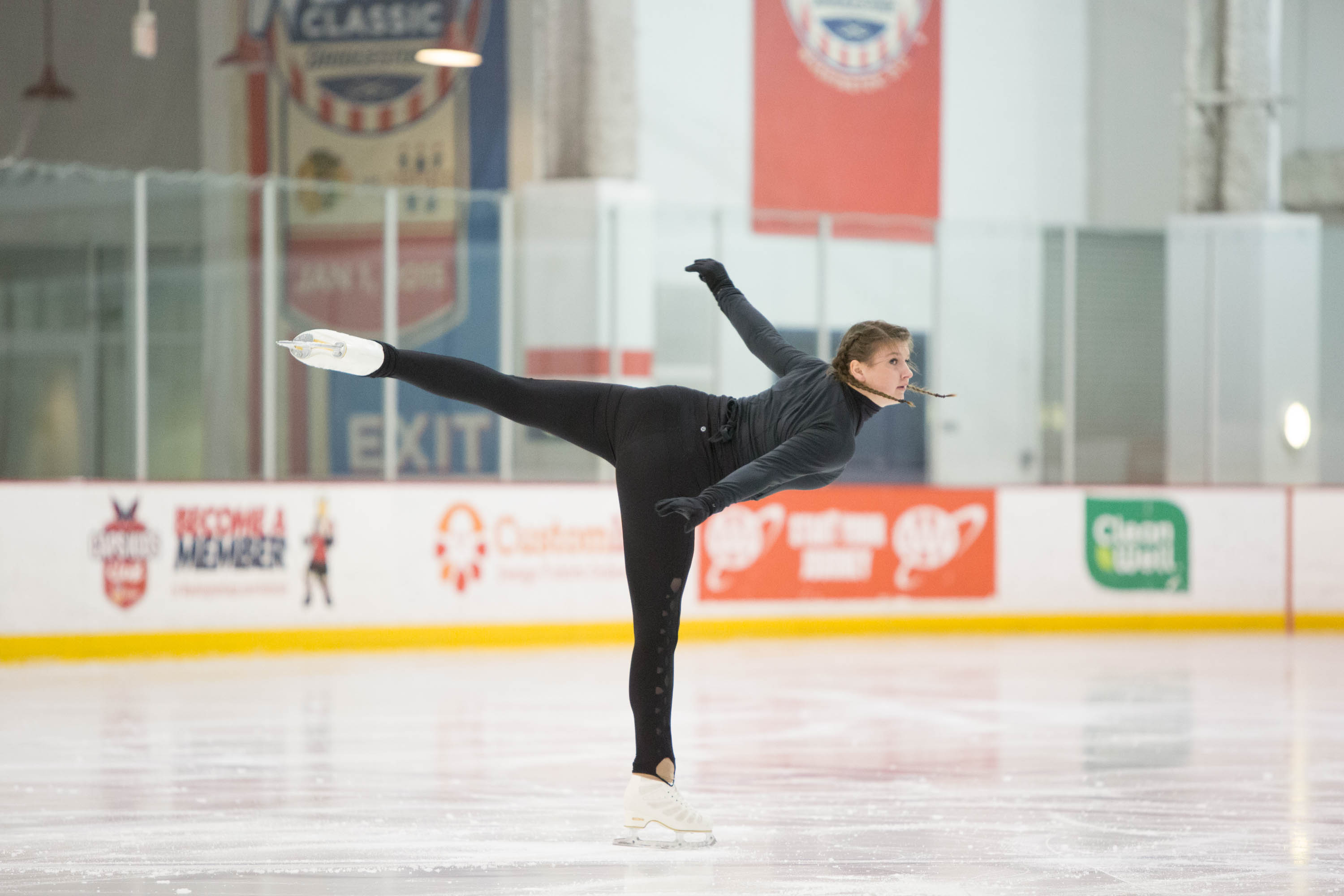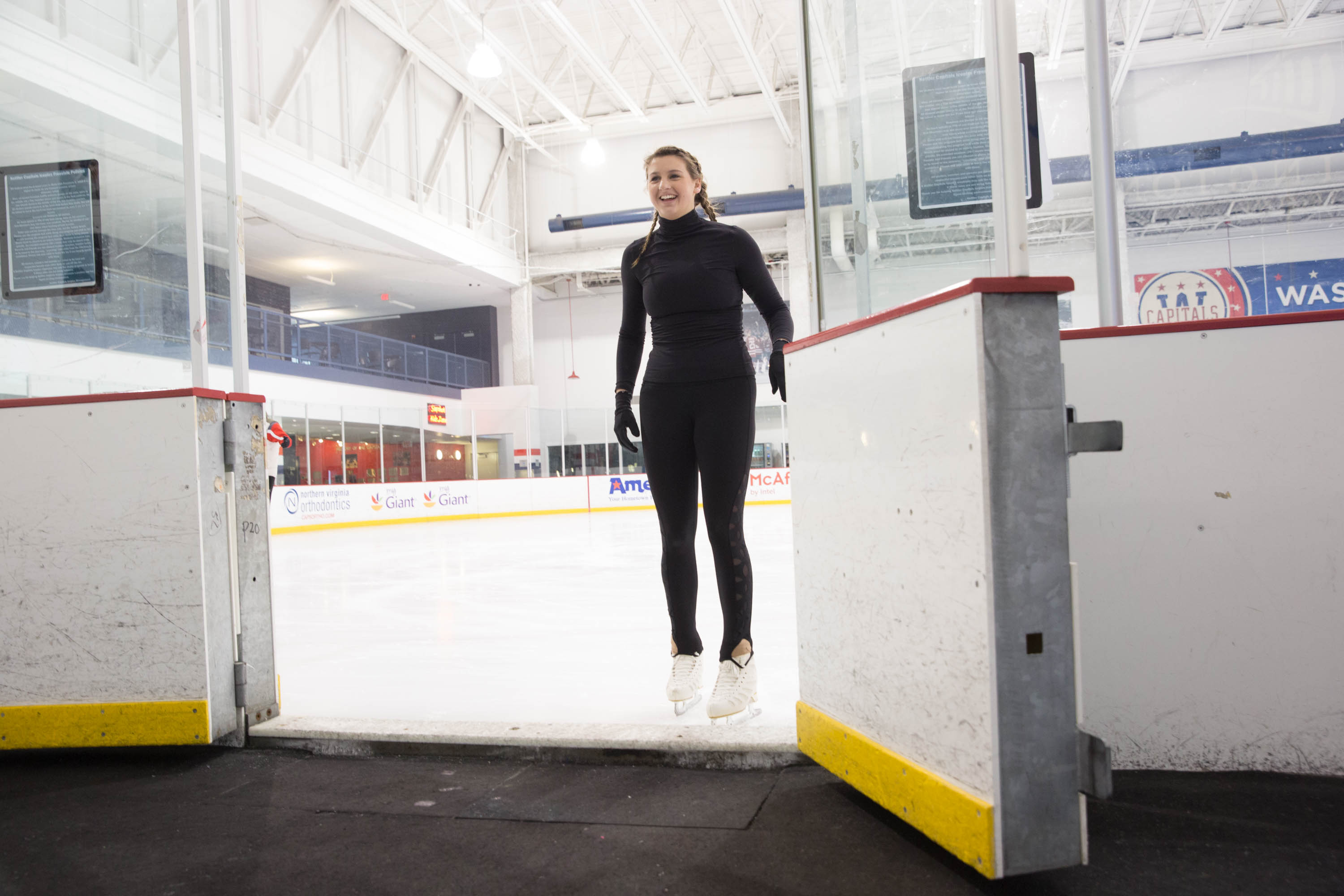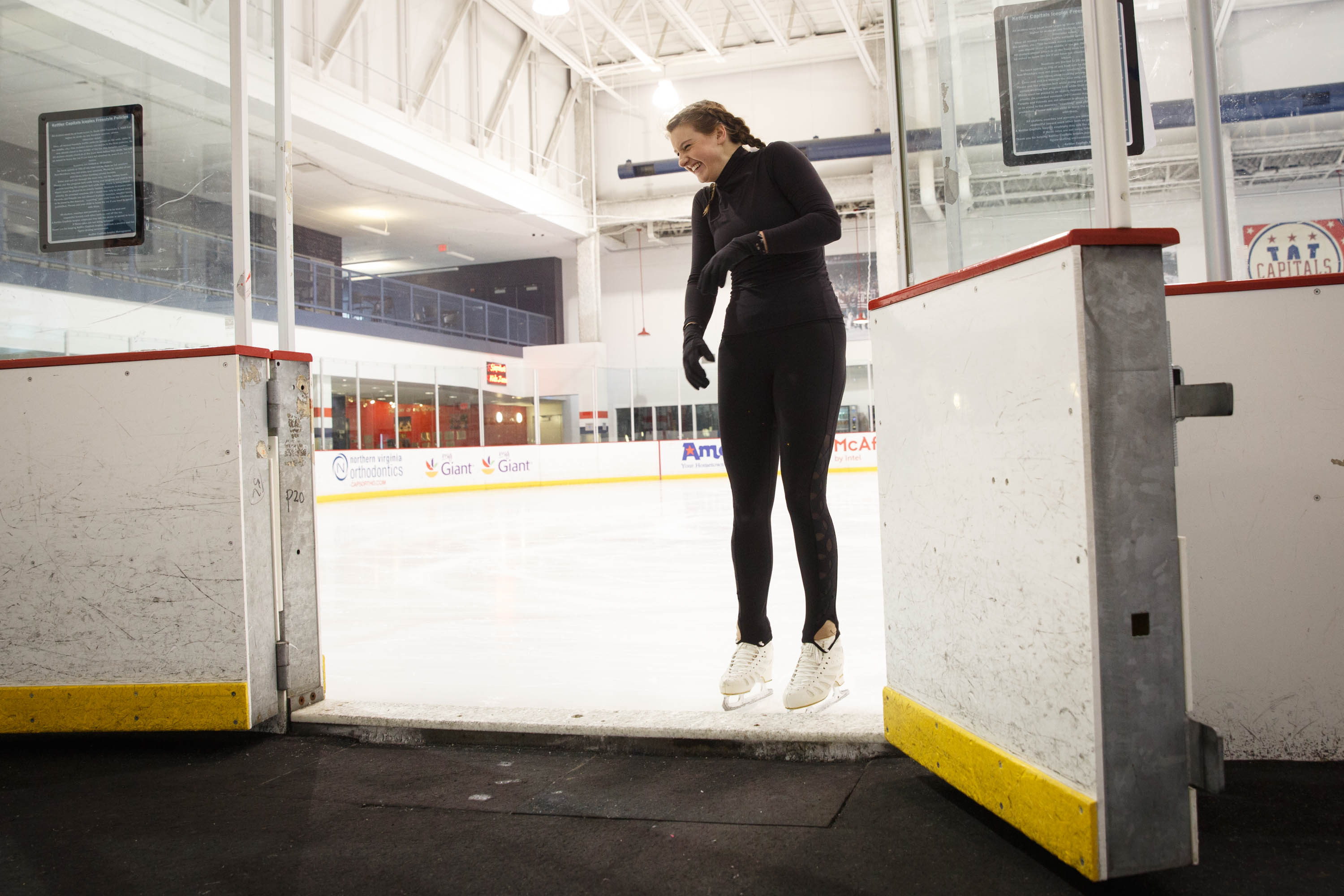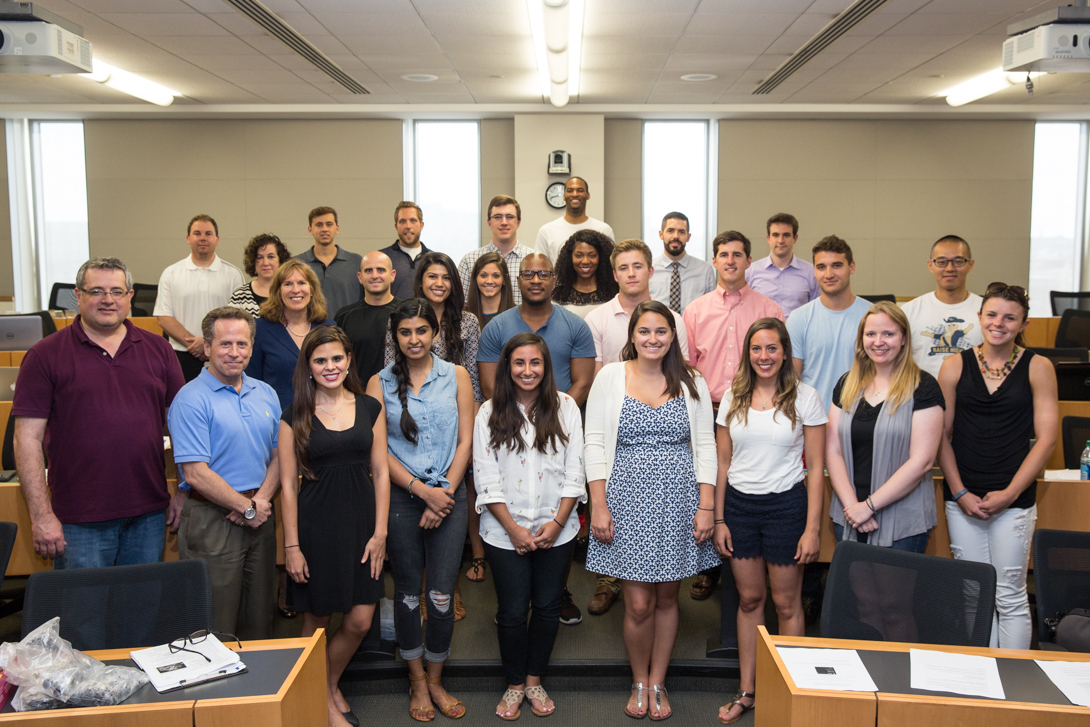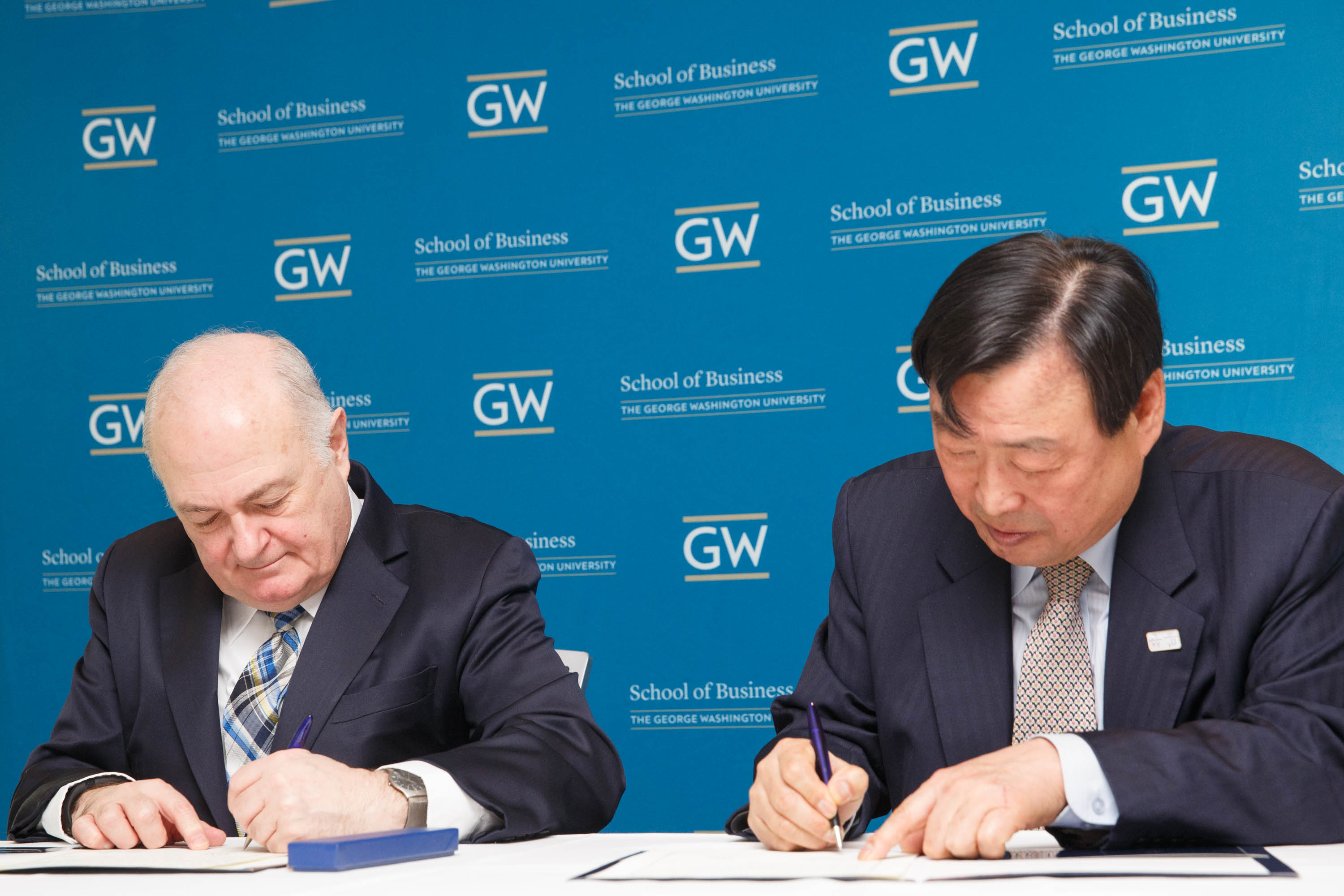By Kristen Mitchell
You could sit next to Colette Kaminski in class all semester and never know she was a world-class athlete—she would never bring it up. The pair of bright white but well-worn figure skates in the bottom of her bag tells a different story.
Ms. Kaminski, known as Coco, spends 10 to 15 hours a week on the ice at rinks in Ballston and Reston in Northern Virginia. In her residence hall closet at the George Washington University, she has tucked away dazzling costumes designed to be worn in front of crowds of cheering fans.
As a figure skater for the Polish national team, Ms. Kaminski traveled to Europe almost every month for competition during fall semester. Yet many acquaintances might not know why she missed classes. Her skating life is one she often keeps private, even from friends.
“One of my friends last year texted me and asked if I wanted to grab lunch, and I was like, ‘I’d love to, but I’m in Iceland,’” Ms. Kaminski joked.
Ms. Kaminski is majoring in international business and political science, but outside of the classroom she has spent the last year and a half gliding across ice in suburban D.C., perfecting figure skating programs to showcase on a world stage.
In January she missed the first two weeks of class while competing in the 2017 European Championships in the Czech Republic, the last contest of her season. She finished 30th. Ms. Kaminski will spend the next few months practicing new skills with her eyes on the 2018 Olympic Games.
Ms. Kaminski grew up as the youngest of four siblings in Minnetonka Beach, Minn. where every child learns to skate, she said. Her father is from Poland, which makes her a dual citizen. In fall 2013, the Polish Figure Skating Association contacted her about joining the growing Polish program.
Ms. Kaminski’s teammates are from all over the world, having received most of their training in places like Italy, Russia and Canada. There is only one ice rink in Poland’s capital, Warsaw, Ms. Kaminski said, so they continue to train far from the country they represent. Ms. Kaminski has kept her long-time coach Peter Biver in Minnesota, who instructs her during academic breaks. While she’s at GW, Ms. Kaminski trains under Northern Virginia-based coach Traci Coleman.

Colette Kaminski observes the ice before starting her warm up. She typically skates early in the morning or during the school day to avoid crowds at the rink. (Logan Werlinger/ GW Today)
Being on the East Coast makes it easier for Ms. Kaminski to travel to international competitions. When she was choosing a college, proximity to a major airport and a relaxed local skating culture were important factors.
“I wanted to have a normal enough college experience, and I wanted to get away from home, and I wanted to try something new and get a fresh start, skating wise and school wise,” she said. “So that was kind of a give and a take, but it has worked out well.”
Ms. Kaminski plans her time on the ice around her classes and the Washington Capitals practice schedule. Like her, the National Hockey League team trains at Kettler Capitals Iceplex in the Ballston neighborhood of Arlington.
She skates six days a week and has to find a time when the ice is available but not too crowded. That translates to early mornings or mid-afternoons when most children are in school. After skating, Ms. Kaminski heads to class and finishes up the day with a dance or barre class in the evening.
The dance classes help on two fronts. They keep her out of physical therapy after a back injury in high school, and they add to her artistry on the ice.
“Last year I did a tango as one of my programs. You kind of have to know the tango dance or at least parts of it for it to make any sense and be relatable,” she said.
For competitions Ms. Kaminski must perform a short program and a free skate. The short program must be under 2 minutes and 50 seconds and include specific jump and spin elements. The free skate, sometimes called the long program, is a 4-minute performance. Both are set to music and judged on execution.
When Ms. Kaminski sails across the ice and suddenly pushes off with a forceful leap, the sound of her blade cutting the hard ice echos through the rink. It’s hard not to hold your breath as her signature twin braids whip through the air as she spins, but falls are rare. She skates like an American, with an aggressive style built on power and athleticism. Because she is skating for Team Poland, Ms. Kaminski is working to adjust her style to a more European feel—more graceful and balletic. If she’s going to compete for Poland, the federation wants her to look the part, she said, but that adjustment hasn’t been easy.
“I am not meant for ballet,” she said.
Ms. Kaminski fell during the European Championships in January, but she said in a competition you have to brush off your mistakes and move on. That attitude has also helped her off the ice, she said.
“Obviously I wasn’t pleased to fall at the end of my program at Europeans, especially because that is my best jump,” she said. “Skating has taught me an abundant amount about perseverance and working hard, and I think that has blended with challenges in my personal life.”
[video:https://www.youtube.com/watch?v=eHEPRfuMMpI&t width:560 height:315 align:center lightbox_title:Coco Kaminski skates at the 2017 European Championships]
Ms. Kaminski speaks enough Polish to get by. She still has family in Poland on her father’s side, she said, and they are proud to see her compete for the country. Polish fans amaze her, waving flags and cheering wildly during competitions. Ms. Kaminski says skating for Poland helps to connect her with her family’s history.
“It’s another place, but it still feels like home. I am always proud to represent Poland, and I do think of it as my heritage and my roots,” she said. “I’m American, but I’m still very Polish, too.”
Growing up in Minnesota Ms. Kaminski made a lot of friends at her home rink. But as they grew up, her peers stopped competitively skating as they started college. Balancing being a full-time student and a professional athlete is challenging, Ms. Kaminski said, but skating is usually the highlight of her day.
“It is something really enjoyable. I think it’s really nice especially in college having something else to do and being able to get off campus and talk to normal people who aren’t all the same age group,” she said. “I’ve just been improving still, so it has never made sense to stop I guess. And I still like doing it.”
Passion drives Ms. Kaminski’s skating career, but her ambitions require sacrifice, she said. She misses out on things that make life at GW special. She missed Inauguration Day festivities and last year’s massive snow storm because of international competitions. During the past two years Poland’s national skating championship has been held over finals week, creating a logistical headache. She works out how she will complete those missed assignments with professors individually.
“It’s really hard,” Ms. Kaminski said. “I don’t know exactly how I do it all the time. I’m just always busy, I like being busy.”
Even though figure skating is a large part of Ms. Kaminski’s life, she prefers to keep her world at school separate. She doesn’t let her friends watch her practice, and she tells them to watch the YouTube video replays rather than wake up before dawn to watch her compete live in a different time zone. Often times her friends are the ones outing her skating life to new people.
Callahan Vertin, a sophomore majoring in international affairs, has known Ms. Kaminski since freshman year of high school. Ms. Vertin often acts as a hype man for her longtime friend, bringing up her recent accomplishments or mentioning Ms. Kaminski’s skating chops to new acquaintances.
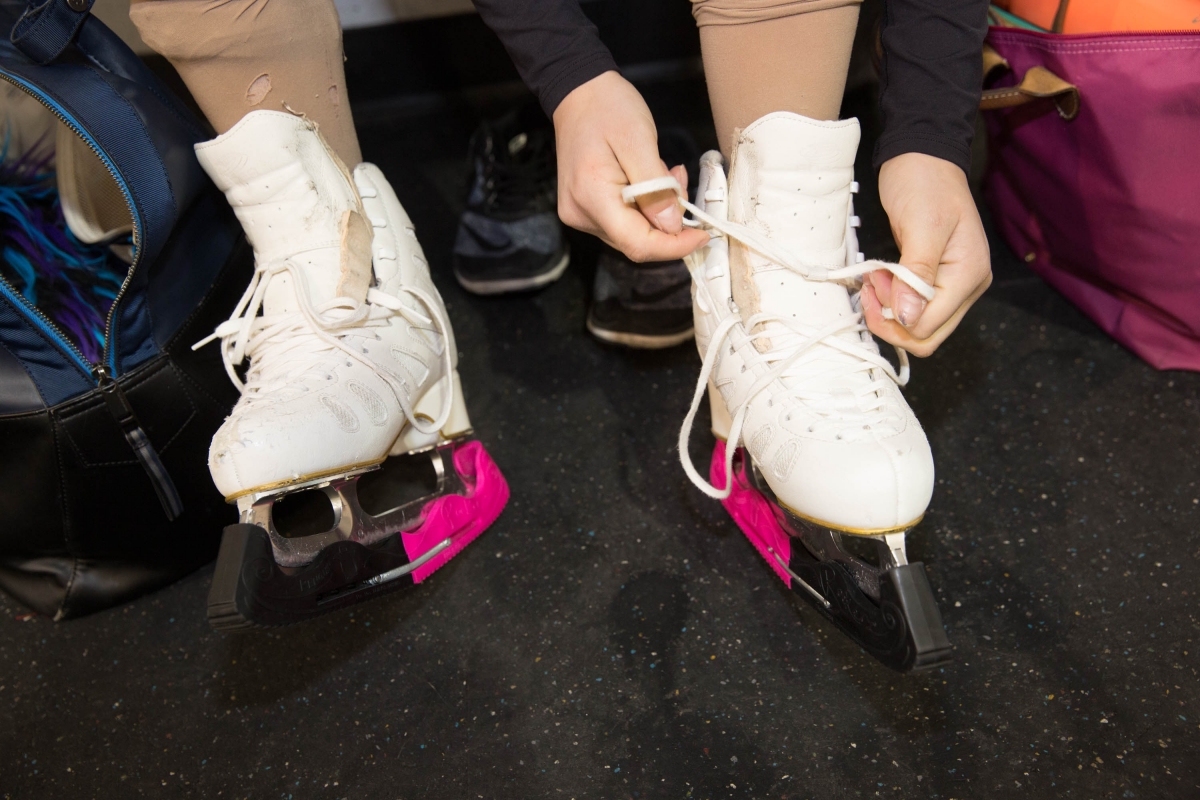
Colette Kaminski laces up her skates at Kettler Capital Iceplex in Ballston, a neighborhood of Arlington. She says the time she spends on the ice is often the most enjoyable part of her day. (Logan Werlinger/ GW Today)
“Nobody really knows what she is doing because she’s not posting about it,” Ms. Vertin said. “As a friend, I’m amazed with what she’s doing. It’s so awesome, and I’m so proud.”
Ms. Kaminski is still early in the off-season. Skating fills more of her days now than they did in December. She plans to debut complex skills this summer, including a triple lutz and triple toe triple toe jump.
In May Ms. Kaminski begins a months-long lead up to the 2018 Winter Olympics in PyeongChang, South Korea. Intensive training awaits her in Minnesota this summer. The Olympics goal requires her take off the fall 2017 semester. In September Ms. Kaminski skates in a qualifying competition in Oberstdorf, Germany, alongside other athletes from small federations. The top six finishers go on to the Olympics.
As the games in South Korea inch closer, Ms. Vertin said she notices her friend opening up a little more about her skating career, talking about her training in ways she has not before.
“I think she’s finally starting to realize that she could really make it to the Olympics,” Ms. Vertin said. “It almost gives me goosebumps to talk about. To see someone give it their all is really, really exciting.”
Olympic talk makes Ms. Kaminski nervous. Talking about the Olympics makes her nervous, but Ms. Kaminski believes that if she trains well during the offseason and hits her programs in Germany, she has a shot at achieving her Olympic dreams.
“It’s doable,” she said. “I would say it’s doable.”


